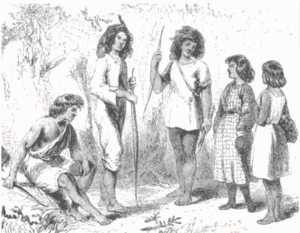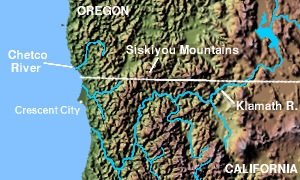Chetco people facts for kids
The Chetco are a group of Native Americans who originally lived along the lower Chetco River and Winchuck River in Oregon. Their name comes from their own language, meaning "close to the mouth of the Chetco River." This language is part of the Athapascan language family.
The Chetco people were once one of the largest tribes on the Oregon Pacific coast. After difficult times, many Chetco people were moved to the Siletz Reservation. Today, many descendants of the Chetco still live in the Chetco area. They are members of the Confederated Tribes of Siletz Indians. Some Chetco descendants are also part of other recognized tribes, like the Cher-Ae Heights Indian Community of the Trinidad Rancheria in California.
Understanding the Chetco Language and Name
The Chetco language is part of the large Athapascan language family. This family also includes many native languages in Alaska. It also includes the Apache and Navajo languages in the southwestern United States. The Tolowa and Tututni tribes in Oregon also speak languages from this family.
The name "Chetco" comes from the word Chit-taa-ghii-li or Chit in their language. This means "close to the mouth of the Chetco River." The Chetco people had nine villages along the Chetco River. Some of these villages were named Chettanne and Chettannene, which were twin villages at the river's mouth. Other villages included Khuniliikhwut and Nakwutthume. The endings like "anne" or "nene" mean "people of a place" or "inhabitants of a village."
A Look at Chetco History and Life
Experts believe the Chetco people arrived on the Oregon coast between 3,000 and 1,000 years ago. They had nine villages along the lower 14 miles of the Chetco River. Their main villages were at the river's mouth, where it meets the Pacific Ocean. The Chetco territory stretched a short distance along the coast. It went from the Pistol River in the north to the Winchuck River in the south. The Chetco were the largest of the 12 coastal tribes in southern Oregon.
The Chetco people were hunter-gatherers. This means they found their food from nature. They hunted deer and elk. They also gathered acorns and mussels. Fishing was another important way they got food. They used dugout canoes to travel on the ocean and rivers. They also used tools made from stone. The Chetco cooked their food over open fires or in simple pots. They shared many customs with the Tolowa tribe to the south. They often married people from the Tolowa tribe.
At their peak, the Chetco tribe may have had about one thousand members. However, their numbers decreased after European-American settlers arrived in the 1800s. In 1853, Chetco villages were damaged. The remaining members of the tribe were moved to the Siletz Reservation. By 1871, the number of Chetco people on the reservation had become much smaller.
Images for kids




